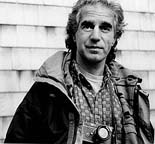|
|
|
|
|
 |
|
|
|
|
|
 |
| Six
years.
Thirty five countries. Three hundred sixty three photographs in one book. Eighty three photographs in a companion book. One hundred thousand copies published each in six languages. Sixteen exhibitions. One photographer. At any given moment---right now for instance--there are any number of photographers risking everything from their financial health to their physical safety, to document circumstances around the world. None of these photographers are on assignment, nor is there any assurance that their work will be published. Anywhere. Truly motivated from inside out-- called and wholly kept as they are by an unrestrained passion for their subjects--these photographers exemplify the highest practical standard and tradition of documentary photography, essentially fulfilling the highest promise of photography: the act of witness. (Witness and objective truth are not necessarily interchangeable here.)
And the work is beautiful. The very least
of these photographs function narratively, telling the story within a story,
something very few photographers do as well as Salgado (Eugene Richards
comes to mind also.) A young girl is seated between parallel bars while
she is being fitted with a prosthetic leg. A man of gentle confidence leans
over her from behind, covering her eyes with one hand, tenderly holding
her chin with the other. She is laughing. She is being loved (p.179). A
Palestinian woman, clearly old enough to remember what happened in 1948,
is living in a refugee camp in Southern Lebanon. She is looking into the
camera. Does she still have the key to her home in Palestine like so many
Palestinian refugees do? Is there hope for her? How long will she wait
and toward what end? It is the simple honesty of images like this that
make this book an extraordinary document.
Understandable as these questions may be, this body of work lays them to rest. And it is these photographs that will certainly endure the test of time and the ones I am most interested in. In a refugee camp in Tanzania (p184-85) people are tending to their everyday life, caught unaware under a threatening sky. There are make-shift cloth tents everywhere. It seems like just another day, except to the photographer. The gathering storm clouds are emphasized in part because they actually appear to be sharper than the camp below. Is this heaven and hell, beauty and sorrow, all in the same frame, seen in the same moment? Is hope alive in this camp? Or is it about to be washed away forever? It is this use of the poetic that I am attracted to in this work, and for which Salgado deserves unqualified praise. With Migrations he has refined his mastery of this kind of dramatic imagery. His first book, The Other Americas, was
filled with a raw, less refined form of this kind of imagery and was very
well received. Workers, his second book, contained some remarkable and
memorable images, but was less effective as a book. First because it was
poorly edited. And second because it was trying to be an epic at the turn
of every page. But where Workers failed, Migrations succeeds. This is partly
because the use of repetition, which was the failing of Workers, was used
wisely in Migrations, letting us know that the same human misfortune is
going on at the same time in different countries around the world. This
alone raises the work to near epic proportions.
In Salgado's case, he made a deal with
each group of kids: "I'm going to sit here. If you want me to take a picture
of you, line up and I'll take a picture of you. Then you go away and play."
The game worked until he moved into a new area. So he lined them up to
be photographed again, and this continued over the life of the Migrations
project.
Finally, it's not uncommon to ask questions
about who benefits from a body of work, especially when that work consists
of compelling, unfortunate circumstances happening to people around the
world. In many cases, the honest answer is that the photographer benefits
far more than any of his/her subjects could. I'm not suggesting there is
anything wrong with this ( though I do have a problem with the pretense
that this is not the case). Salgado overwhelms this issue by sheer effort.
To his credit, he and his wife and staff have gone to great lengths to
insure that this work is effective in the world. Understanding that his
responsibility extends far beyond producing the images, The Children will
be exhibited at the United Nations in the Fall, with fifteen additional
exhibitions and a huge print run for both books in six languages. I can't
think of anyone who works harder, is more passionate and wholly committed
to getting the job done.
Nubar Alexanian
|
| CONTENTS
PAGE |
| Contents Page | Editorials | The Platypus | Links | Copyright |
| Portfolios | Camera Corner | War Stories | Dirck's Gallery | Comments |
| Issue Archives | Columns | Forums | Mailing List | E-mail The DJ |